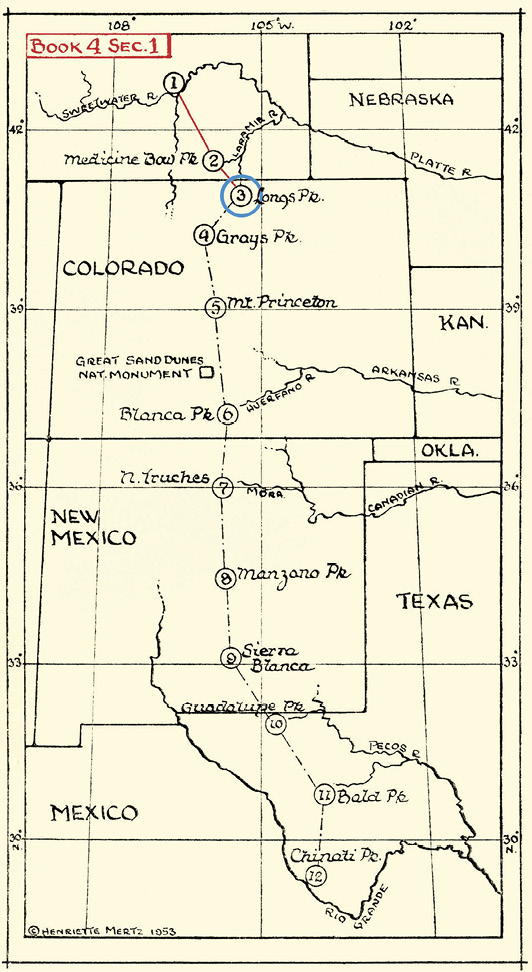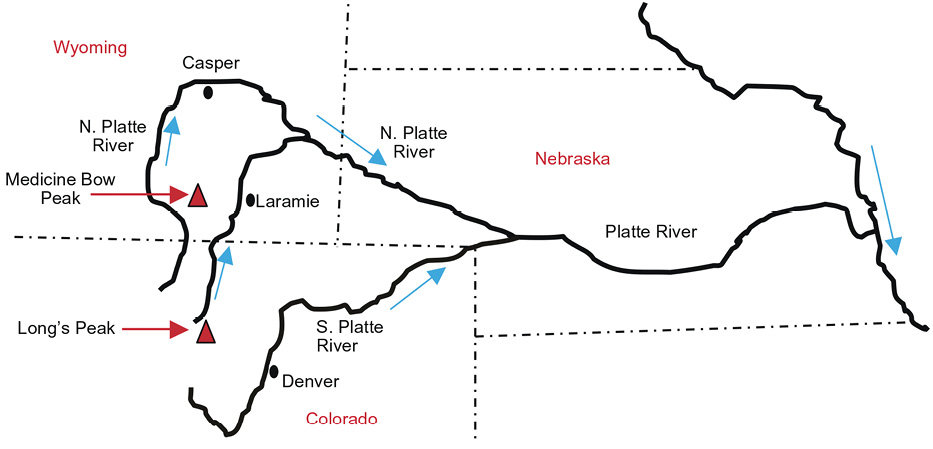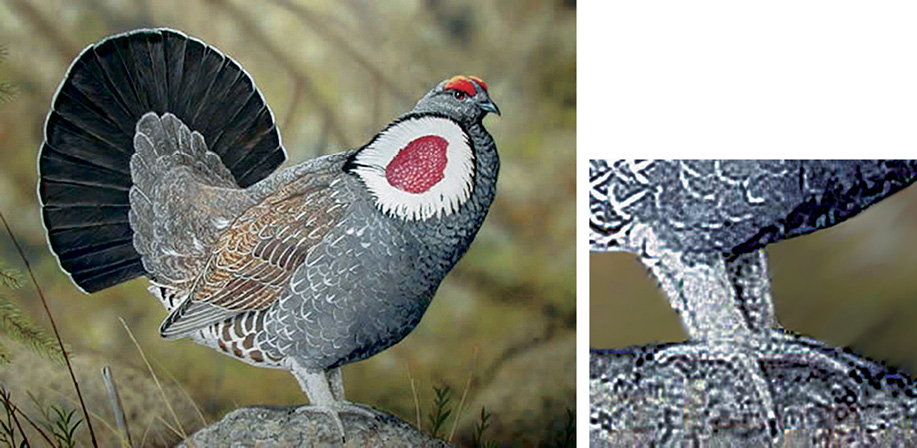And it says that, three hundred li to the south, KEUCH-WANG Mountain (or Aspen Mountain) is to be found. Upon this there are many gems and much gold, and below it many green jade-stones. Wild animals are found there which look like dogs with six legs. These are called TS’UNG-TS’UNG, the name being given them in imitation of their cry. Birds are also found there which look like domestic fowls, but which have hair like a rat. These are called TSZ’ rats. When they are seen, the country is subject to great drought. The CHI River is found here, a stream flowing northerly into HU River. In this there are many lancet-fish. These are of a dark color, spotted (or striped) with blue, and have a bill like a lancet. [These were originally found in the Eastern Sea, and they are now found in the KIANG-TUNG River also.] Those who eat them are not subject to epidemic diseases. (Vining translation of Shan Hai Jing)

Mertz Note:
One hundred miles south, “Aspen Mountain” probably is Long’s Peak, Colorado. Mile after mile of the most spectacular golden-leafed Aspen trees stretch clear across Colorado – truly an unforgettable sight, even to the Chinese. Gold, as is well known, abounds in this area from Steamboat Springs to Cripple Creek; [mottled green jade, such as is known in Mexico, comes from this region.]41 The CHI River is a fork of the Laramie which flows north. The two rivers, one from Medicine Bow and the other from Long’s Peak, join – as the Chinese noted. Identification of the fish, rainbow or speckled trout or any other, will be left to the fishermen of Colorado. The birds with hair like a rat, may be bats.
Author’s Comments:
Here the Chinese account mentions the Hu River, which we previously identified at Medicine Bow Peak as the Laramie River. Tracing the Laramie to its source takes us right to the mountains on which Longs Peak sits!
Today the Laramie River starts at Longdraw reservoir. However, before the reservoir was built, the Laramie would have still started there. This is at the northern end of the Front Range in north central Colorado.42

There is a gulch on the western side of Longs Peak. The CHI River could very well be this gulch which runs north-south. Since the Laramie River starts at the end of the mountains it is only logical that streams flow down from the mountains to form the headwaters.
Therefore, to arrive at Longs Peak it appears that the Chinese followed the Laramie south from the area near Medicine Bow Peak to its source. To the west of the Laramie River are the headwaters of the North Platte. To the south and east, cradling this area, is the north flowing South Platte River. From there the Laramie flows north until many miles later it joins the North Platte. North and South Platte rivers intersect in Nebraska where the name changes to simply “Platte River.”
Around 2006 Dr. H. Mike Xu, who was educated in China and America, sent me a tracing of a petroglyph (rock carving) that he had seen in Colorado that he believed was pre-1800 BC Chinese writing. Previously Dr. Xu published both a book and an article in an academic journal in which he identified writing from celts in Mexico as Chinese of that same period.43 This area of Colorado is also the vicinity of where the Granby Stone, with its pre-1800 BC Chinese writing, was found.
The Continental Divide Trail, which we encountered at each location so far, does not cross Longs Peak but comes very close at Grand Lake.
On the day we flew into that area we had visited Denver Museum of Natural History to view their awesome display of minerals found in Colorado. It highlighted “Tom’s Baby,” the largest piece of gold ever found in Colorado (156 troy ounces or 13 pounds). On July 23, 1887, Tom Groves walked into Breckenridge, Colorado cradling in his arms the huge nugget wrapped in a blanket. Thus it was named “Tom’s Baby.”

Tom’s Baby
Principal Gold-Producing Districts of the United States list six locations for gold in Boulder County Colorado where Longs Peak is found.44 One location near Longs Peak is Eugenia Mine, a gold mine which operated for about 12 years starting in 1905. The mine appears to have been somewhat successful in that they used heavy equipment and went 1000 feet deep.
There was lot of opposition to Eugenia Mine from naturalist neighbors. Rocky Mountain National Park bill was signed in 1915. Mining was allowed to continue, but soon the mine was abandoned. Gold is still found at numerous other sites across Colorado.
In conflict with Mertz’s statement above, jade was not among the minerals the Denver museum displayed for Colorado. A curator suggested that there were other green minerals in Colorado which one might mistake for jade. The region just north of Longs Peak has more than 70 minerals, including numerous gems. The internet displays green amazonite as “Colorado Jade.” Wyoming, which boasts jade as their state gem, is only 50 miles away from Longs Peak. It is feasible that jade might have been found at this location at one time.
I believe that the Shan Hai Jing’s mention of a bird with hair is the identification of another animal native to North America. Mertz thought the Chinese were describing bats. The Rocky Mountain National Park does list bats among the animals living there. However, the Chinese of that era would have known the difference between bats and birds. Chinese revere bats. For ages Chinese have depicted bats in art and regard bats as omens of good fortune.

Dusky Grouse. Note the feathery legs -
courtesy of Oregon Department of Fish and Wildlife
The Shan Hai Jing stated that the birds here looked like domesticated fowl, surely a reference to chickens, which according to Chinese archeology they had bred by 2000 BC.45 The English name for these birds, dusky grouse (Dendragapus obscurus), was recently changed from blue grouse. Until now it was believed that the first literary mention of them was by Lewis & Clark in the early 1800s. They are native to the Rocky Mountains of North America and are about the size and shape of chickens. In the colder months they grow downy hair-like feathers (which some have referred to as hair) on their legs and feet. In fact, at a glance the down on gray “hairy” legs of dusky grouse looks similar to fur of mice.
It is difficult to know what type of fish they were discussing. Perhaps it was another American species. Colorado pikeminnow, have a bluish cast and a long beak-like snout. Now endangered, pikeminnow can grow to nearly 6 feet long. Another possible candidate for this fish is the razorback sucker which is also native to that area and endangered. That fish has an elongated head which is small in proportion to its body. However, whether these fish have healing properties has not yet been discovered in recent times.
On another one of the Shan Hai Jing journeys it was mentioned that by eating a certain fish one could help prevent swelling. Because of the location, which Mertz placed as the Columbia River, she thought it was a reference to salmon. Recently in the 21st century it was discovered that Omega 3 in salmon does indeed help prevent swelling.
I am puzzled by what the dog with six legs could possibly be. When I checked with an expert in China to re-translate this, he said that this was “a holy beast that looks like a dog with six legs.”
Most people snicker when they hear this description. However, there are anomalies in nature as when twins are conjoined. A few years back a calf in my area of Virginia was born with six legs. However, that is certainly not the norm.
When I was a child and my family was back in the US and living in Indiana, a Chinese man from Taiwan visited. He asked to cook and was shocked when the very first egg he opened had a double yolk. He immediately asked whether all eggs in America had double yolks. Perhaps that was the case with the six-legged dog.
However, perhaps the reference to this six-legged creature was an idiom or had a figurative meaning. One might say in English, “The wolf is at the door,” (meaning threat of poverty) and not expect anyone to look for a real wolf.
In Chinese mythology there was a creature representing chaos which was variously named Konton, Dijiang, or Hudun. It was described as a divine dog or a large beast with six legs, four wings, and no head or eyes.
In A Chinese Bestiary: Strange Creatures from the Guideways Through Mountains and Seas by University of California Press, Richard E. Strassberg discusses a six-legged Hudun which he also refers to as Dijiang. Strassberg quotes from Master Zhang regarding this beast then explains its figurative meaning:
Here Hudun can be read as a figure of primordial chaos who is a victim of purposeful activity, destroyed by the well-intentioned though dangerously misguided efforts of humanizing civilization.46
Therefore, the figurative meaning of the six-legged beast for the Shan Hai Jing travelers could have been that the area by Longs Peak was wild and chaotic but that the Chinese were bringing civilization and order.
From Loveland, Colorado we journeyed to Estes Park to enter Rocky Mountain National Park and to see Longs Peak. Traveling up Route 34 we were awed by the beauty of the glistening cliffs and the beautiful yellow aspen as we ascended
Big Thompson Canyon Road. We could understand why the Chinese might have named this Aspen Mountain.

Estes Park, elevation 7522 feet, lies in the valley below Longs Peak. We had read that in the fall elk congregated in town for the mating season. At the visitor’s center we learned that in fact elk were gathered nearby so hurried off to find them.

Longs Peak - courtesy of NPS
In total we saw 14 huge elk. They were near a pond and on a golf course. One enormous elk with huge antlers lay in the grass no more than 15 feet from where we walked by. The golf course had fenced off certain areas to keep the greens from being destroyed. We saw no one playing nor could they even if they wanted to challenge the elk for that turf. A male elk would bugle and another male across the lake would bugle back.

There are lots of little shops in Estes Park and we did a quick run through of several before going on our way again. We had hoped to take the tram up that day for a view of Longs Peak, but the tram was closed. We had also hoped to get a good view of Longs Peak on the day we flew into Denver, but because of recent forest fires in Colorado the skies were hazy then and the view obscured.
Travel books suggested that another way to get a view of Longs Peak was to journey up Trail Ridge Road toward Grand Lake and look back, so we did that. With a scenic highway designation, this is the highest continuously paved highway in the United States.
When we were there it was the weekend. The road was crowded and very winding – sometimes with sheer drop offs and no guard rail. We stopped several times to enjoy the beauty. At one stop, tiny ground squirrels raced out toward us. When we did not feed them, looking for food, they ran over the hands and fingers of others. It is illegal to feed wild animals in the park because they need to learn to be self sufficient. However, apparently some before us had fed them.

Longs Peak at 14,255 feet is the sixteenth tallest of 54 mountains over 14,000 feet high in Colorado. It has a unique flat-topped profile. For most of the year, climbing Longs Peak is in winter conditions which require specialized gear. Hikers accidentally die there almost every year, partly because of the sheer cliffs. Hiking any of the high peaks, one also needs to be alert to altitude sickness which is brought on by lack of oxygen and failure to acclimate. Symptoms include headache, shortness of breath, tightness in the chest, marked fatigue and weakness.